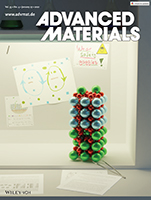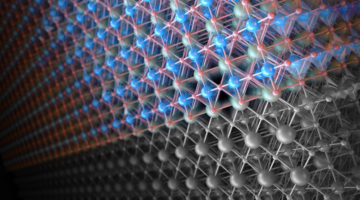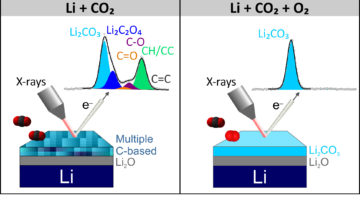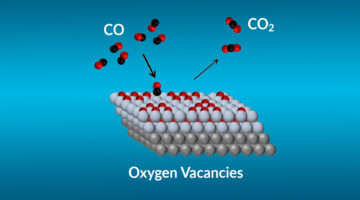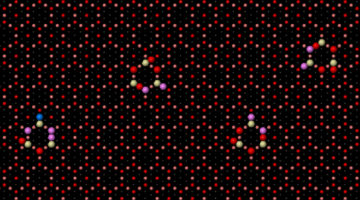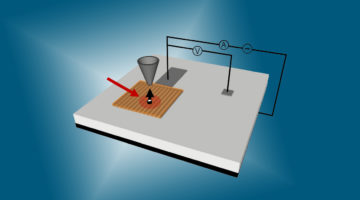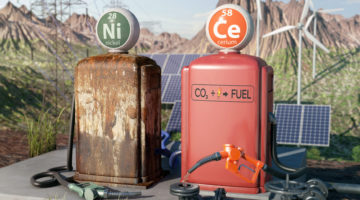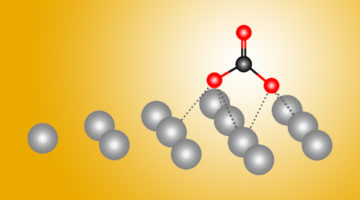Researchers identified how ion and electron transfer naturally balance at the LaAlO3/SrTiO3 oxide heterointerface, affecting the band alignment and magnetic signature of the interface. The results show that Sr ions are more mobile at the interface than in the bulk, implicating a high importance of ionic charge transfer in oxide heterostructures. Read more »
A 1-Atom-Deep Look at a Water-Splitting Catalyst
X-ray experiments revealed an unexpected transformation in a single atomic layer of a material that contributed to a doubling in the speed of a chemical reaction—the splitting of water into hydrogen and oxygen gases. This process is a first step in producing hydrogen fuel for applications such as electric vehicles powered by hydrogen fuel cells. Read more »
New Insights into Lithium-Metal Surface Reactions for Next-Generation Batteries
In this work, researchers studied how CO2 gas modifies the chemical composition of lithium-metal surfaces. A better understanding of the interactions between lithium and surrounding gases will help design stabilization strategies and move from lithium-ion technology to high-energy-density technologies based on lithium metal. Read more »
Increasing the Efficiency of CO Catalytic Conversion
Using a combination of tools at the ALS and other facilities, researchers probed specific mechanisms affecting the efficiency of catalysts for CO-to-CO2 conversion. The work brings us closer to the rational design of more effective catalysts for cleaning up toxic CO exhaust and advances our understanding of fundamental catalytic reactions. Read more »![]()
![]()
How Water Promotes Catalysis of Methane to Methanol
Researchers unraveled how water helps catalyze the conversion of methane, the main component of natural gas, into methanol, a liquid fuel. The work supports the efficient production of methanol and other useful chemicals and could help reduce the amount of greenhouse gases released by the flaring and venting of methane. Read more »![]()
![]()
2020 Shirley Award to Honor Miquel Salmeron
By taking surface studies from ultrahigh vacuum to near-ambient pressure, Miquel Salmeron’s work at the ALS has had deep impact on a broad range of scientific questions, revealing the chemical, electronic, and mechanical properties of surfaces and interfaces on the nanometer (and often atomic) scale. Read more »
The Bottleneck Step of a Complex Catalytic Reaction
The rate-limiting step in catalysis involving oxygen uptake was identified through analysis of the reaction pathways and observations performed under operating conditions. The work lays the foundation for improving the efficiency of energy conversion and storage devices such as fuel cells, catalytic reactors, and batteries. Read more »![]()
![]()
New Catalyst Resists Destructive Carbon Buildup in Electrodes
Key challenges in the transition to sustainable energy can be met by converting CO2 to CO through the use of solid oxide electrolysis cells. But because these can suffer from carbon deposition at the electrodes, researchers have now identified and tested a new, cerium oxide–based catalyst that is more resistant to carbon buildup. Read more »![]()
A New Path to Carbon Dioxide Transformation
Combining ALS experiments with quantum-mechanical calculations, scientists found dramatic differences in how carbon dioxide (CO2) reactions begin on silver as opposed to copper. Both metals help transform CO2—a greenhouse gas—into more useful forms, and this new atomic-level data could help make the process more efficient. Read more »![]()
![]()
Fuel from the Sun: Insight into Electrode Performance
The mechanisms limiting the performance of hematite electrodes—potentially key components in producing fuel from the sun—have been clarified in interface-specific studies under realistic operating conditions, bringing us a step closer to storing solar energy in chemical fuels. Read more »![]()
![]()
